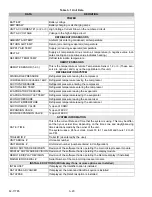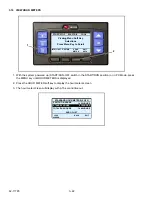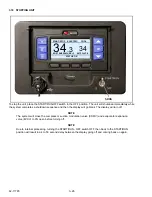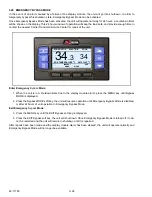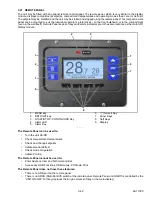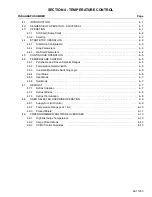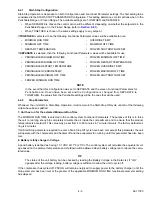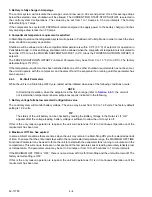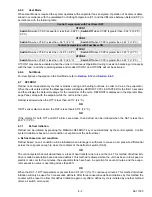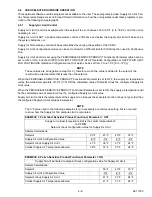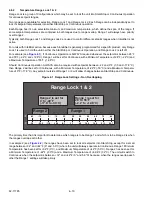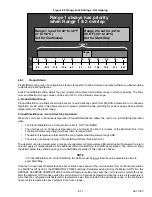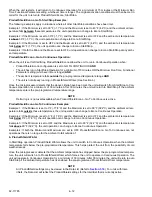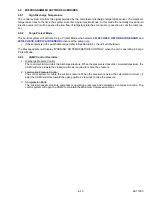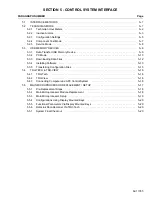
4–1
62-11785
SECTION 4
TEMPERATURE CONTROL
NOTES
1. If the unit is in an alarm condition, the control system alarm response may override the operation
described herein. If an alarm is displayed in the MessageCenter, refer to the specific alarm description in
for “Unit Control” descriptions.
2. With the complex control interactions in use with the APX control system there are many user selected
and preprogrammed software overrides which may change the operation of the unit. Refer to
for complete descriptions of these features.
4.1
INTRODUCTION
This section describes operation of the unit when in Start-Stop Operation and Continuous Operation.
For a description and flow diagram of the refrigerant system component interaction while in cooling, refer to
. For a description of the system component interaction in heating or defrost, refer to
4.2
SEQUENCE OF OPERATION - ELECTRICAL
With the battery connected (see schematic diagram
), power is available from the battery to fuse F7:
• and fuse F1 to the module logic circuit at main microprocessor module (MM) terminal 1MM-6, to the stepper
valve module (from 1MM-8 and SP-16 to 1SMV-6), to the display module (from 1SVM-8 to DM-10), to the
first contactor control board (1CCB) (from SP-16 through HVB7-B and HVB1-B and SP52 to 1CCB-04) and
to the second contactor control board (2CCB) (from SP-52 to 2CCB-04).
• and fuse F3, PCM-34 and SP-18 to SVM at 2SVM-22 & 3SVM-22 (for operation of the valves).
Potential power is also established for the battery charger logic circuit (BTCY TEMP/VOLTAGE), the power enable
relay (PER) normally open contacts (through fuse F5), and the buzzer (B - through fuse F1).
Once the module logic circuit is powered, the modules begin to communicate over the controlled area network
(CAN).
The “HI” CAN connectivity is established from the main microprocessor (1MM-2, through connectors HVB7-C &
HVB1-C) to the first contactor control board (at terminal 1CCB-05) and to the second contactor control board (from
1CCB-06 to terminal 2CCB-06). The connectivity continues (from 2CCB-05 and through terminals HVB1-H and
HVB7-H) to SP-13. From SP-13 the connectivity continues to the stepper valve module (at 1SVM-5) and to the dis-
play module (from 1SVM-2 to DM-2).
The “LO” CAN connectivity is established from the main microprocessor (1MM-4, through connectors HVB7-D &
HVB1-D) to the first contactor control board (at terminal 1CCB-17) and to the second contactor control board (from
1CCB-29 to terminal 2CCB-29). The connectivity continues (from 2CCB-17 and through terminals HVB1-G and
HVB7-G) to SP-14. From SP-14 the connectivity continues to the stepper valve module (at 1SVM-7) and to the dis-
play module (from 1SVM-4 to DM-6).
To start the unit, SROS is placed in the START/RUN position. Power flows from SROS through terminal DM-7, the
J1 jumper, the high pressure switch (HPS) and the overload ground fault (through terminal HVB1-K, OV-+12V OV-
S+, SP-63, terminals HVB1-F & HVB7-F and PCM-15) to the power enable relay (PER) coil. Confirmation of power
circuits are established from splice point SP-24 back to the main microprocessor at 2MM-35, SP-23 to 3MM-16 and
from SP-63 to the second contactor control board at 2CCB-12. If any of these circuits is broken, the appropriate
alarm will be activated.
If conditions are correct for operation, the main microprocessor will energize Power Enable Relay (PER) by provid-
ing ground through PCM16 from 3MM18. Energizing PER closes its normally open contacts to provide power:
• through fuse F10 to the main microprocessor at 3MM-34 & 3MM-23.
• through fuse F12 for satellite communication (SATPWR).
• through fuse F11 for the light bar (LB) green LED’s.
• through fuse F9, contacts HVB7-E and HVB1-E to SP-55. From SP-55 power is supplied to the contactor
control boards ( and 2CCB-14+) for operation of the contactors.
During operation the main microprocessor will complete the potential circuits, by supplying ground, energizing or
de-energize the required components.
Summary of Contents for VECTOR 8100
Page 2: ......
Page 4: ......
Page 12: ...62 11785 viii ...
Page 16: ...62 11640 12 ...
Page 18: ...62 11785 ...
Page 24: ...62 11785 1 6 1 3 SAFETY DECALS ...
Page 25: ...1 7 62 11785 ...
Page 26: ...62 11785 1 8 ...
Page 27: ...1 9 62 11785 ...
Page 28: ...62 11785 1 10 ...
Page 30: ...62 11785 ...
Page 50: ...62 11785 ...
Page 82: ...62 11785 ...
Page 96: ...62 11785 4 14 ...
Page 98: ...62 11785 ...
Page 129: ...5 31 62 11785 ...
Page 130: ...62 11785 5 32 ...
Page 134: ...62 11785 6 4 ...
Page 138: ...62 11785 ...
Page 230: ...62 11785 ...
Page 271: ...8 41 62 11785 ...
Page 272: ...62 11785 8 42 ...
Page 274: ...62 11785 ...
Page 286: ......
Page 287: ......
Page 288: ...62 11785 10 8 ...
Page 292: ......
Page 293: ......


